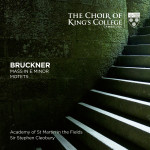|
Back
10/25/2020
“Mass in E Minor – Motets”
Anton Bruckner: Ecce sacerdos magnus, WAB 13 – Mass n° 2 in E minor, WAB 27 – Tota pulcra es, WAB 46 – Virga Jesse, WAB 52 – Locus iste, WAB 23 – Ave Maria, WAB 6 – Christus factus es, WAB 11
The Choir of King’s College, Cambridge, Academy of St. Martin in the Fields, Sir Stephen Cleobury (conductor)
Recording: Chapel of King’s College, Cambridge, England (March18-19 and June 24-25, 2019) – 57’06
King’s College KGS0035 (Distributed by PIAS) – Booklet in English – Lyrics in Latin and English

   
Similar to Bach, another devout composer of sacred music, Anton Bruckner did not travel far from home. The Austrian composer, best known for nine symphonies and a Te Deum, was born in Ansfelden, now a suburb of Linz, Austria, in 1824, and died in Vienna in 1896.
In between, he remained within the boundaries of his native land, singing as a chorister in nearby St. Florian Monastery, where he later became organist. It was physically under that organ that he chose to be buried. In 2015, I took the stairs across from the Monastery gift shop down into the crypt and stood beside his austere sarcophagus, a wall of monks’ skulls keeping watch in the shadows. But though Bruckner did not travel far as the crow flies nor did he lead a life of pleasure, his mind and spirit soared, and seldom with greater depth of feeling than in the Mass n° 2 in E minor, WAB 27.
The seven-part Mass was composed in 1866 to celebrate the construction of the Votive Chapel of the new Linz Cathedral. Later in life, Bruckner called the premier three years later one of the most magnificent days of his life. Today, the Mass is the centerpiece of a new album from the Choir of King’s College, Cambridge, the final album of longtime conductor, Sir Stephen Cleobury, who passed away last year several months after this recording was made. Scored for an eight-voice mixed choir as well as brass and woodwinds, the singers are joined by musicians of the Academy of St. Martin in the Fields. The album is rounded out with the inclusion of several of Bruckner’s motets.
Lasting a little over a half hour, this is a lovely reading of Bruckner’s Mass, the voices of the choristers hallowed by the haunting resonance of the Chapel. What a fine swan song this makes for Cleobury, who served as music director of the Choir since 1982. His direction honors the great architectural substance of Bruckner’s composition, while coaxing the most wonderful solo passages and effortless counterpoint from the singers and musicians. The overall effect is both serious and uplifting, fleeting and eternal, expressed with Bruckner’s signature sensuality in the declaration of strong, sweet chords in voice and brass.
In the opening sections, the instrumental voices seemed a little pale, but grew in importance as the Mass unfolded. The third section, the “Credo” (“I believe”) opened boldly but turned reflective in the Adagio section. The somber Crucifixion reference morphed into a sweeping Resurrection against chattering 16th notes in the winds. The “Benedictus” featured some attractive playing by French horn and oboe, followed by harp-like arpeggios in the woodwinds. The work ended with a richly melodic “Agnus Dei” with a somewhat quizzical feel to it as rising whole notes dissolve in E major with the words, “Dona nobis pacem” (“Give us peace.”).
The album also contains six of Bruckner’s nearly 40 motets. Locus iste is the shortest, a gradual in the Latin Mass sung just before the Gospel. Taken from Hebrew Scriptures, the text states that “this place” (“locus iste”) is made by God and is beyond reproach. While frequently sung at church dedications, the narrative could easily be focused on the sacredness of the planet as a whole and made part of ceremonies supporting conservation and celebrating the Earth.
The motet, Ecce sacerdos magnus (“Behold the great priest,” referring to Jesus), has a polyphonic Renaissance feel to it, captured with intensity and fervor by the ensemble. Less attractive was the Ave Maria, a bold version of Mary’s declaration to bear God’s child. Here I found the boys’ voices a bit shrill, and overall lacking in a quality of wonder and mystery. More successful was Virga Jesse, (“a shoot from the branch of Jesse blossomed”), a gradual expressing awe at the virgin birth and God’s plan for peace in the world. Bruckner’s writing contains some sinuous chromaticism in the middle voices, a text-book lesson in creating musical interest with only four vocal lines.
Overall, the motets offered an opportunity to hear Bruckner—the titan of symphonic majesty—on a small, intimate scale. But it is the grand Mass in E minor, not the pleasing miniatures, which leaves the strongest impression. This is a worthy performance of that work, and a fitting memorial to the life, faith and contributions of an important conductor of sacred scores.
Linda Holt
|